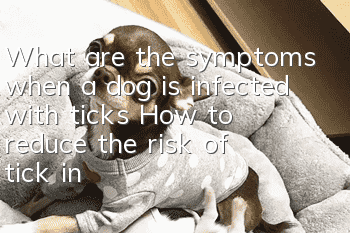What are the symptoms when a dog is infected with ticks? How to reduce the risk of tick infection in dogs?

Pet parents like to walk their dogs and let their dogs eat and play well. This is also the wish of the dog owners. However, when walking their dogs in the summer, it is a high incidence period for dogs to be infected with ticks. Let’s learn about ticks to help your dog reduce the chance of infection, and what to do if your dog is infected with ticks.
The period from early summer to golden autumn is the period when ticks and other parasites are active. Ticks can not only cause various skin problems, but can even cause tick-borne infections. Dogs are frequent visitors who play in various grasses and small gardens, and they may be targeted by ticks if they are not careful.
If we want to keep our dogs away from ticks, we need to first understand what ticks are and how they are infected.
What are ticks & the dangers of ticks?
Ticks are temporary parasites on the body surface of many vertebrates and are the vectors and reservoirs of some zoonotic diseases. Ticks can cause skin allergies, skin ulcers, and skin inflammation. If a tick infection is not treated, the host may be infected with a tick-borne infection, which can be fatal in severe cases. April to October is the peak season for ticks. We must prevent ticks in advance. If we find that we or our pets are infected with ticks, we must promptly treat them with medication.
How dogs become infected with ticks:
Ticks mostly live on the leaves of various vegetation outdoors. Once a pet passes by, the ticks will take the opportunity to crawl onto the pet, suck blood, and release saliva into the skin. So among domestic pets, dogs are more likely to be infected with ticks than cats.
So when we suspect that our dog has ticks, how should we further judge?
How to tell if my dog has ticks:
1. Know what ticks look like
· Most ticks have an oval-shaped body and a small head.
· Common ticks are mainly reddish brown, dark brown, black and gray.
· The body length of ticks usually does not exceed 6 mm, and some species of ticks are even much shorter than 6 mm. After a female tick is full of blood, its body can expand to more than 1 cm.
· Ticks have 6 legs before they reach adulthood and 8 legs as adults.
2. Symptoms that may occur after a dog is infected with ticks:
· Ticks may cause hair loss and, in more severe cases, allergic dermatitis. A small red rash will appear on the skin.
· When a pet feels itchy, it will shake its head and scratch.
· Severe tick infection can cause anemia.
· Some ticks produce toxins that weaken muscles, causing "tick paralysis". At this time, pets will have muscle paralysis and difficulty moving.
· A tick bite may cause a fever. Symptoms of fever include weakness, loss of appetite, tremors, and unusual breathing.
3. How to find ticks on dogs
Ticks cannot jump or fly, they can only crawl on their hosts. When it bites the skin, it will adhere tightly to the surface of the skin until it is full of blood. Before entering, comb your dog's coat with your fingers and apply gentle pressure to feel for any bumps on the skin. Ticks can range in size from a pinhead to a grape. Focus on the ears, face, neck and paws, "armpits" and around the anus.
If you feel bumps on the skin, pull back the hair to see the skin and look for black, brown, or brown bugs.
It should be noted that because we cannot see the head of a tick when it sucks blood, we can only see its body, so sometimes we are not sure whether what we see is a tick or a black mole. And sometimes we clearly suspect that there are ticks on the dog but cannot find them. At this time, we all need to go to the pet hospital for further examination.
What to do if you find a tick:
1. Emergency measures after a tick is discovered:
Use tweezers to approach the tick from the side, close to the skin.
If someone is helping, one person can be responsible for removing the tick, and the other person can hold the dog to keep the dog calm, so as to prevent the dog from moving around when removing the tick and causing part of the tick's body to break off in the body. Then use tweezers to approach the tick from the side against the skin.
· Pull straight up
Don’t jerk, don’t twist. Be careful not to squeeze the tick's bloated abdomen, as this will push the tick's toxins into the dog's body.
· Treat wounds
After cleaning the tick, clean the bite and surrounding skin with an antiseptic, or dab antibiotic ointment near the wound. Always remember to wash your hands after handling it.
Friendly Tips: Ticks are poisonous, so please wear gloves or cover your hands with paper towels before handling them. If the tick cannot be removed or there is residue during removalIf the head of the tick is lodged in the dog's skin, or if the dog appears to be in pain or irritation or the area around the wound becomes red, stop pulling on the tick and contact your veterinarian.
2. Drugs to remove ticks:
Parasites are divided into two categories: internal parasites and external parasites. Corresponding anthelmintic drugs also include oral anthelmintics and deworming drops for external use.
Commonly used external insecticide drops include Fulian, Tiaoluling, Baichongshuang, etc.
Here is an introduction to the usage of Fulien:
· After confirming that the hair is dry, break off the tip of the dropper.
· Remove the hair between the dog's shoulder blades (neck). Dropping it on this location will prevent the pet from licking it. Hold the bottle vertically and drip the Fulin drops directly onto the skin, being careful not to drip on the hair. The medicine will evaporate on the hair, and a small amount will enter the sebaceous glands and be stored, which will limit the effectiveness of the product.
· Press the dropper to confirm that the entire tube has been dripped.
· Pay attention to signs of reaction in dogs after using the product, especially if it is the first time to use the product. If there is loss of appetite, vomiting or diarrhea, excessive drooling, listlessness, etc., immediately bathe the dog with warm soapy water and take it to the pet hospital.
Note: Fulian is suitable for all breeds of dogs and cats over 8 weeks old. The correct specification of Fulien drops must be selected according to body weight.
3. Choose insecticide drops:
When choosing topical drops, you should pay attention to the following points:
· If you have children or pregnant women at home, tell your doctor.
· Do not buy repellents without permission. Some repellents contain permethrin, which can be used by dogs but is harmful to cats.
· If your dog is currently taking other medications, is too old or too young, is sick, pregnant or nursing, or is allergic to deworming drugs, your veterinarian may be more likely to recommend that you use a special comb to comb out ticks. , then soak the tick in a bowl of hot, soapy water.
The above is the treatment operation after a dog is found to be infected with ticks, but for the threat of ticks, it is more important to take preventive measures to nip it in the bud.
Tick prevention and control:
· Before your dog goes out, you can use insecticide drops as a preventive measure to reduce the chance of infection.
· Vacuum your home every day, including carpets, upholstery tools, and kickboards.baseboards and basement. Steam clean regularly, especially in areas where owners and dogs sleep.
· Reduce or prohibit dogs from playing in areas with lush vegetation.
· Wash your dog’s and owner’s bedding at least once every two to three weeks.
· You can wear a special repellent collar for your dog.
There are many people who do not dare to walk their dogs after they heard that walking dogs can infect ticks. In fact, don’t worry too much. As long as prevention is done, dogs can also avoid being infected with ticks. If your dog has been infected with ticks, take relevant treatment as soon as possible. Ticks are not as difficult to eliminate as imagined.
- Why is the dog losing hair in patches?
- Is the Corgi's unformed stool caused by catching a cold? What causes it?
- Why are Basenji dogs banned?
- More than 50% of dogs suffer from this disease, but most dogs ignore it! ! !
- How to take care of Samoyed’s hair
- Which pet dog is the smartest? Pet dog IQ rankings!
- What are the main reasons for dog hair loss?
- Can dog distemper be cured? How to treat canine distemper?
- What are the causes of heart failure in dogs?
- How to train an adult dog to follow? How to train a dog to follow!



